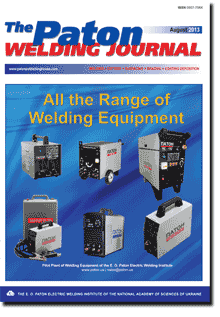| 2013 №08 (06) | 2013 №08 (08) |

The Paton Welding Journal, 2013, #8, 42-45 pages
WET UNDERWATER WELDING OF LOW-ALLOY STEELS OF INCREASED STRENGTH
S.Yu. MAKSIMOV and I.V. LYAKHOVAYA
E.O. Paton Electric Welding Institute, NASU. 11 Bozhenko Str., 03680, Kiev, Ukraine. E-mail: office@paton.kiev.ua
Abstract
Conditions of welding directly in water environment limit greatly the feasibility of producing quality welded joints of low-alloy steels of increased strength. This is due to the fact that mechanical properties of weld metal are inferior to properties of base metal, and the initiation of cold cracks in the heat-affected zone (HAZ) is possible. Investigation of weld metal structure showed that depending on degree of alloying the weld areas, adjacent to the fusion line, can have different structures of transient compositions. The obtained results allowed working out requirements to the deposited metal composition to prevent the formation in HAZ of a brittle interlayer with an increased hardness, which is a place of initiation of cold cracks. Welded joints of steel 17G1S of 14 and 40 mm thickness, made under water using developed electrodes with rods of high-alloy steel, provide weld metal mechanical properties, corresponding to the requirements of class A of Specification AWS/ANSI D3.6 on underwater welding, and also resistance of welded joint against crack formation. Electrodes can be used in repair and construction of special-purpose metal structures, made of low-alloy steels of increased strength of up to 40 mm thickness. 8 Ref., 6 Figures, 1 Table.
Keywords: wet underwater welding, low-alloy steels of increased strength, weld, structure, chemical composition, cracks, mechanical properties
Received: 28.05.13
Published: 28.08.13
References
1. McKeown, D., Abson, D. (2006) Wet welding repairs. Shipping World and Shipbuilder, 207(5), 24-26, 28.
2. Rowe, M., Liu, S. (2001) Recent developments in underwater wet welding. Sci. and Technology of Welding & Joining, 6(6), 387-396.
3. Dariusz, F., Grzegorz, R. (2011) Effect of shielded-electrode wet welding conditions on diffusion hydrogen content in deposited metal. Welding International, 25(3), 166-171.
4. Bartzsch, J., Daniel, S., Bouaifi, B. et al. (1997) Arc welding with austenitic filler metal for underwater application. In: Proc. of 16th Intern. Conf. on Offshore Mechanics and Arctic Engin. Е OMAE 1997 (Yokohama, Japan, 13-17 April, 1997).
5. Maksimov, S.Yu., Savich, I.M., Zakharov, S.M. et al. (2003) Structure and properties of the metal deposited under the water by flux-cored wire with a nickel sheath. The Paton Welding J., 4, 18-21.
6. Moroz, L.S., Chechulin, B.B. (1967) Hydrogen brittleness of metals. Moscow: Metallurgiya.
7. Bailey, N. (1991) Welding under water Е a metallurgical appraisal. In: Proc. of 1st Int. Offshore and Polar Engin. Conf. (Edinburg, UK, 11-16 August, 1991).
8. Maslennikov, P.S., Russo, V.L. (2000) New electrodes for underwater welding. Svarochn. Proizvodstvo, 11, 26-27.
Suggested Citation
S.Yu. MAKSIMOV and I.V. LYAKHOVAYA (2013) WET UNDERWATER WELDING OF LOW-ALLOY STEELS OF INCREASED STRENGTH. The Paton Welding J., 08, 42-45.The cost of subscription/purchase order journals or individual articles
| Journal/Currency | Annual Set | 1 issue printed |
1 issue |
one article |
| TPWJ/USD | 384 $ | 32 $ | 26 $ | 13 $ |
| TPWJ/EUR | 348 € | 29 € | 24 € | 12 € |
| TPWJ/UAH | 7200 UAH | 600 UAH | 600 UAH | 280 UAH |
| AS/UAH | 1800 UAH | 300 UAH | 300 UAH | 150 UAH |
| AS/USD | 192 $ | 32 $ | 26 $ | 13 $ |
| AS/EUR | 180 € | 30 € | 25 € | 12 € |
| SEM/UAH | 1200 UAH | 300 UAH | 300 UAH | 150 UAH |
| SEM/USD | 128 $ | 32 $ | 26 $ | 13 $ |
| SEM/EUR | 120 € | 30 € | 25 € | 12 € |
| TDNK/UAH | 1200 UAH | 300 UAH | 300 UAH | 150 UAH |
| TDNK/USD | 128 $ | 32 $ | 26 $ | 13 $ |
| TDNK/EUR | 120 € | 30 € | 25 € | 15 € |
AS = «Automatic Welding» - 6 issues per year;
TPWJ = «PATON WELDING JOURNAL» - 12 issues per year;
SEM = «Electrometallurgy Today» - 4 issues per year;
TDNK = «Technical Diagnostics and Non-Destructive Testing» - 4 issues per year.


